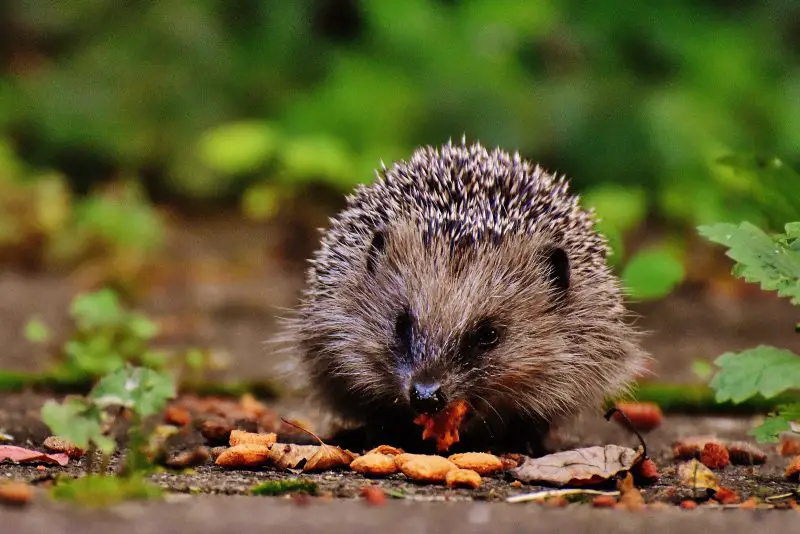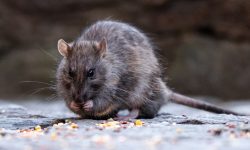Hedgehogs are remarkable little insectivores with a surprisingly diverse appetite. Whether living in the wild or cared for in captivity, these spiny mammals rely on a balanced diet to stay active, healthy, and alert. Their natural menu includes insects, small animals, fruits, and various plants, depending on the species and ecosystem.
Wild hedgehogs spend their nights foraging for food, relying on keen hearing and smell rather than sight. They explore under logs, leaf piles, gardens, and woodlands searching for protein-rich prey. Captive hedgehogs eat similarly, but their diet must be carefully balanced to prevent obesity and nutritional deficiencies.
Understanding what hedgehogs eat is essential for anyone who observes them in nature or keeps them as pets. A healthy diet supports their metabolism, quill strength, digestion, and reproductive health. Below is a complete guide based on natural feeding behavior, including the 20 foods hedgehogs love the most.
Understanding the Hedgehog Diet

Hedgehogs as Natural Insectivores
Hedgehogs are primarily insectivores, meaning insects and invertebrates make up most of their natural diet. Their sharp teeth and strong jaws are designed for crushing beetles, worms, and other small prey. Although they consume some plant matter, their digestive system works best with protein-rich foods.
How Hedgehogs Hunt for Food
Hedgehogs forage at night using smell and sound. They rustle through underbrush, sniffing out insects, larvae, and small animals. Their slow movement conserves energy, while their pointy snout helps them explore tight spaces where prey may hide.
Feeding Needs in Different Seasons
During warm months, hedgehogs enjoy a wide variety of foods. In cooler seasons, especially before hibernation, they eat more high-fat prey to store energy. Their changing diet helps them survive temperature shifts and ensures proper nutrient intake all year long.
20 Foods Hedgehogs Love the Most
1. Beetles
Beetles are one of the hedgehog’s main protein sources. They provide essential amino acids that support muscle development and daily activity. Wild hedgehogs often flip over logs or dig shallow soil to locate beetles hiding beneath.
Their hard exoskeleton offers fiber-like material that helps improve digestion. Hedgehogs consume both soft-bodied and hard-shelled beetles depending on what they can find. A diet rich in beetles supports overall strength and immune health.
Because beetles are abundant in forests and gardens, they give hedgehogs a reliable food source throughout spring and summer.
2. Earthworms
Earthworms offer moisture, protein, and easy digestion. They are especially important during dry seasons when other prey is harder to find. Hedgehogs detect worms by vibrations and movement in the soil.
These worms provide hydration, which is vital for hedgehogs living in hot climates or areas with limited water sources. Their soft bodies make them ideal for juveniles learning to hunt.
Earthworms also help hedgehogs maintain gut balance, making them one of the most beneficial natural foods available.
3. Caterpillars
Caterpillars are rich in protein and fats, giving hedgehogs concentrated energy during long foraging nights. Their soft texture makes them easier to digest than many other insects.
However, hedgehogs carefully avoid hairy or toxic caterpillars. They choose species with smooth bodies to ensure safe feeding without irritation.
Caterpillars are plentiful in shrubs, gardens, and forest edges, making them a staple in the hedgehog’s diverse insect diet.
4. Slugs
Slugs are slow, abundant, and easy for hedgehogs to catch. Their high moisture content helps with hydration, especially during summer months.
Although slimy, slugs offer a surprising amount of protein. Hedgehogs often find them under stones, plant pots, and moist garden soil.
This reliable prey helps hedgehogs thrive in suburban environments where slugs are plentiful.
5. Snails
Snails provide a fatty, nutrient-rich meal, but hedgehogs must break through the shell to reach the soft interior. Their strong jaws make this easy for adults.
These small animals contribute minerals such as calcium, which support bone strength. Wild hedgehogs eat both shelled and shell-less snails depending on availability.
Snails are a key food source after rain, when moisture draws them out of hiding.
6. Millipedes
Millipedes are part of a hedgehog’s natural invertebrate diet. These slow-moving prey items offer moderate protein and hydration.
Hedgehogs select non-toxic species, avoiding brightly colored millipedes that may be dangerous. They typically target small, soft-bodied individuals in leaf litter.
Feeding on millipedes helps diversify their nutrient intake during late summer.
7. Crickets
Crickets offer lean protein and are easy for hedgehogs to catch. Their jumping behavior triggers a hedgehog’s instinct to hunt, providing mental stimulation.
The soft exoskeleton makes digestion easy, especially for juvenile hedgehogs. Crickets also promote strong teeth and jaw development.
In captivity, gut-loaded crickets are one of the healthiest insect options to mimic natural feeding.
8. Grasshoppers
Grasshoppers supply protein, fats, and natural fiber. Their larger size gives hedgehogs more calories per catch, making them efficient prey animals.
Hedgehogs often locate grasshoppers in tall meadows or garden grass during twilight hours. Their high moisture content is especially useful for hydration.
These insects help hedgehogs build fat reserves during pre-hibernation periods.
9. Ant Larvae
Ant larvae are soft, nutritious, and abundant in many environments. Hedgehogs find them by tearing into shallow ant nests.
These larvae offer protein and moisture that support rapid energy replenishment. Although small, they are often eaten in large numbers.
This prey helps hedgehogs meet nutrient needs when food is scarce.
10. Bird Eggs
When available, hedgehogs eat small bird eggs found on the ground. These eggs provide protein, fats, and important minerals.
Hedgehogs do not climb to steal eggs; instead, they take advantage of nests built at low heights, such as ground-nesting birds.
Eggs are considered opportunistic rather than regular prey, but they offer rich nutrition when discovered.
11. Baby Mice
Occasionally, hedgehogs consume newborn mice, especially in overgrown fields or old buildings. This prey is soft, nutrient-dense, and easy to swallow.
They rarely hunt rodents actively, instead taking advantage of exposed nests. This food source provides complete nutrition during seasonal shortages.
Baby mice help hedgehogs maintain energy levels during early spring.
12. Frogs
Small frogs offer lean protein and hydration. Hedgehogs catch them near ponds, wetlands, or garden water features.
They target slow or juvenile frogs, which are easier to consume safely. Frog meat helps strengthen muscles and support growth.
This prey is more common in damp, shaded environments.
13. Lizards
In some regions, hedgehogs may eat small lizards. These reptiles offer protein, minerals, and fats needed for sustained activity.
Lizards are harder to catch due to their speed, making them occasional treats rather than daily meals. Hedgehogs usually target injured or young individuals.
This diet variety reflects the hedgehog’s opportunistic nature.
14. Fruits
Wild hedgehogs enjoy fallen fruits such as apples, berries, and pears. These offer natural sugars, antioxidants, and hydration.
Fruit consumption increases during summer and autumn when plants produce seasonally. Hedgerows and forest edges provide easy access to ripe fruit.
Although fruits are not a main food, they help diversify the diet and support energy reserves.
15. Vegetables
Hedgehogs nibble on vegetables like carrots, peas, and leafy greens, especially those growing in gardens. These foods provide vitamins and moisture.
They eat only small amounts of plant matter, supplementing their insect-rich diet. Tender vegetable shoots are preferred over tough stems.
This plant consumption is helpful for hydration during dry periods.
16. Mushrooms
Some hedgehogs eat wild fungi when insects are scarce. Mushrooms offer moisture and trace nutrients.
They choose safe mushroom species instinctively, avoiding toxic varieties. Forest floors provide easy access after rainfall.
Mushrooms help hedgehogs maintain hydration in woodland habitats.
17. Seeds
Seeds found in grasslands and gardens add small amounts of fats and carbohydrates to hedgehog diets.
They are not primary foods but serve as occasional supplements. Hedgehogs often consume seeds while foraging for insects hidden underneath.
This food is most common in late autumn.
18. Roots
Tender roots and tubers occasionally become part of a hedgehog’s diet. These offer minimal nutrition but help satisfy hunger when prey is scarce.
Roots also supply moisture, especially in drought conditions. Hedgehogs dig shallow soil to access them.
These foods are temporary substitutes rather than regular meals.
19. Pet Food (Occasionally)
Hedgehogs sometimes eat cat kibble or dog food left outside. These foods mimic insect nutrients but must be consumed sparingly.
Dry kibble provides crunch and protein, especially during winter foraging. Hedgehogs find these leftovers easily in urban areas.
However, they prefer natural foods in most cases.
20. Carrion
Hedgehogs may eat small amounts of carrion when fresh prey is unavailable. This provides protein without the effort of hunting.
They typically consume only fresh carcasses to avoid spoiled meat. Carrion acts as an emergency food source during cold months.
This scavenging behavior helps them survive in challenging environments.
FAQs About the Hedgehog Diet
Do hedgehogs eat strictly insects?
No. Although insects are their primary food, hedgehogs also eat fruits, eggs, small animals, and plant matter when available.
Can hedgehogs eat human food?
They should avoid salty, sugary, or processed foods. Natural, unseasoned items are safer.
Do hedgehogs drink water?
Yes. Hedgehogs need fresh water daily, especially in warm climates or after eating dry foods.
Can hedgehogs eat cat food?
High-quality dry cat food can be given in moderation for pet hedgehogs.
Do hedgehogs eat garden pests?
Yes. They consume slugs, beetles, caterpillars, and other insects, making them beneficial for gardens.
What foods should hedgehogs avoid?
Milk, bread, avocado, raisins, chocolate, and onions are harmful.
Do hedgehogs eat meat?
They eat small amounts of natural prey like baby mice or frogs but do not eat cooked human meats.
How often do hedgehogs eat?
Wild hedgehogs forage nightly and eat small amounts frequently.
Final Thoughts
Hedgehogs have a diverse and adaptable diet that allows them to thrive in forests, grasslands, and even gardens. Understanding what hedgehogs eat helps protect them in the wild and ensures proper care for those kept as pets. Whether hunting insects or nibbling fruit, these small mammals rely on nutrient-rich foods to stay active, healthy, and resilient.






